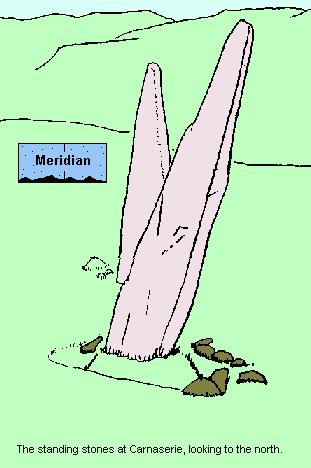
Carnasserie, Argyll
Stones
of Wonder
QUICK LINKS ...
HOME PAGE
INTRODUCTION
WATCHING
THE SUN, MOON AND STARS
THE
MONUMENTS
THE
PEOPLE AND THE SKY
BACKGROUND
ARCHAEOASTRONOMY
USING
THE SITE DESCRIPTION PAGES
VISITING
THE SITES
THE
LEY LINE MYSTERY
THE
SITES
ARGYLL
AND ARRAN
MID
AND SOUTH SCOTLAND
NORTH
AND NORTH-EAST SCOTLAND
WESTERN
ISLES AND MULL
Data
DATES
OF EQUINOXES AND SOLSTICES, 1997 to 2030 AD
DATES
OF MIDSUMMER AND MIDWINTER FULL MOONS, 1997 to 2030 AD
POSTSCRIPT
Individual
Site References
Bibliography
Links
to other relevant pages
Contact
me at : rpollock456@gmail.com
Stone Alignment NM834007*
How to find : Some 1.5km north of Kilmartin village on the A816 turn left into the car park for visitors to Carnasserie castle. Walk up the castle track from there, but when it turns right, carry straight on up the hill for about 700 metres, following the power lines. The alignment is on a flat area in the field, beyond a stone dyke.
Best time of year to visit : Midday or any clear night.
This site is in a most attractive situation, high up overlooking the ruins of Carnasserie castle, with the craggy hills of mid Argyll all around.
 The
monument is an alignment of two stones, both about 2.5 metres tall, placed
approximately two metres apart. The northern stone is firmly upright,
but the southern one now leans to the east. The stones were surveyed on
the bearing through the two bases of the stones.
The
monument is an alignment of two stones, both about 2.5 metres tall, placed
approximately two metres apart. The northern stone is firmly upright,
but the southern one now leans to the east. The stones were surveyed on
the bearing through the two bases of the stones.
To the south, the azimuth of 168.2° with a horizon of 2.3° gives a declination of -31.0°, but here the horizon is very close; it is likely that the northern line is the one intended to be marked by the stone alignment.
To the north, the azimuth of 348.2° with a relatively high horizon altitude of nearly 6° gives a declination of +38.5°, well beyond the extreme setting position of the moon. However, it is difficult to be sure of the true line the stones are intended to indicate; the southern stone is leaning, and its faces are also not exactly in line with the northern stone. It may well be that this alignment was another attempt to mark the meridian; implicit in this is the pointer to the Pole, around which all the stars appear to revolve, and true south, where the sun and moon are always at their highest.
This line is also laid out at the aligment at Salachary, a distance of only 3km away to the north, and there seems little doubt that the sites are related.
The experience of watching the stars move around a fixed point over a full night or part of a night is not one that many modern people in western society ever have. Therefore it is probably more difficult to engage with or relate to the spectacle, compared with that of seeing the sun or moon rise or set, which is within the experience of most of us, even if it is usually accidentally.
When or if you do watch the stars over a night, you will become aware of several things: how forcefully the earth seems to be at rest and the stars to be moving around it; how cold it gets even in summer; how satellites now move regularly across and against the stars.
It is obvious that unlike a lunar or solar line an alignment marking the Pole is not necessary, since it reveals itself inevitably every night; it may be that it was conceived of as a sacred and powerful direction, around which the universe circled, and so had to be given due respect. We will never know these things for certain.
More images of Carnasserie - click on image to view full size -
View from east (74K)
View from west (83K)

